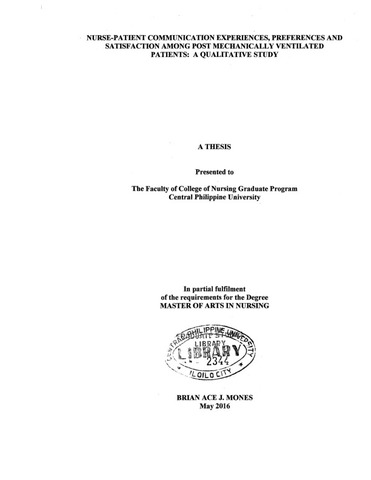Nurse-patient communication experiences, preferences and satisfaction among post mechanically ventilated patients: A qualitative study
요약
Communication is one of human basic needs. Undoubtedly, the field of nursing practice requires constant communication between nurse and the patient. The aim of the study was to determine nurse-patient communication experiences, preferences and satisfaction among post mechanically ventilated patients. This is an exploratory study employing case study approach. A qualitative design was used using non-probable purposive sample. The data saturation occurred with nine respondents. Semi-structured interview was used to collect data. All interviews were audio digital recorded. The interviews were transcribed verbatim and analyzed using Colaizzi’s framework.
Of the nine participants, seven were males and two were females. The youngest of the nine was 28 and the two oldest were 79. The other six were aged 34 and 75. Only one was single and the rest were married. In addition, with respect to academic preparation, four were college graduate; one was college undergraduate and four were high school undergraduate. Only one was professional.
Majority of the respondents experienced Acute Respiratory Failure Type I preceding intubation and received mechanical ventilation treatment for less than eight days.
The participants who had undergone mechanical ventilation treatment had different nurse-patient communication experiences during the period of treatment. Eight participants reported varied physical experiences including pain and discomfort with endotracheal tube and while being suctioned, thirst and dryness of the mouth, sleep deprivation and self-care deficit; and spiritual and emotional experiences, such as feeling of helplessness and dependency, awareness of own mortality and spiritual coping; and feelings of security and well-being towards significant relatives.
Communication barrier was considered as a major problem by mechanically ventilated patients. Most of them experienced disrupted interactions due to their difficulty in expressing what they wanted, and their perceived lack of information from the staff.
Assessing participants’ health condition and needs were the common focus of nurse-patient communication, which also included health teaching which usually lasted for less than five minutes. Patients’ responses to communication were brief, mostly by nodding or shaking their head to indicate yes or no response, respectively.
The participants’ non-verbal communication can be categorized into three groups: 1) signals for attention, 2) expression of needs or request, and 3) the positive or negative response.
Note writing (pen and paper) and the use of alarm system aided communication. One participant used a cellphone. Three participants complained about difficulty in writing legibly. Most participants preferred to use signs and gestures since they found these effective.
Participants usually initiated nonverbal cues when they needed something, but most of the time, nurses initiated communication during their patient rounds and machine/equipment checks. Most nurse-patient communications were about care, focusing on health assessment, care provision and patient’s need care.
Two types patient satisfaction were identified, one is process-based satisfaction and the other is outcome-based satisfaction. The first type is illustrated by the experiences of two participants who shared that they were satisfied with the way the nurses communicated with them. On the other hand, the other participants reported that they were satisfied with how the nurses tried to improve their emotional and spiritual comfort.
Based on the findings, the following conclusions were derived:
Participants encountered physical, spiritual and emotional experiences; and nurse-patient communication challenges, while on mechanical ventilation treatment irrespective of their medical condition and duration of their mechanical ventilator treatment.
Nurse-patient communication was usually brief, concise and mostly nurse initiated. Patient health assessment, need identification and health teaching were the common focus of nurse-patient communication. The participants developed individual style of non-verbal communication depending on one’s intention.
The participants’ satisfaction was based on how the nurse-patient communication was established and maintained and what favorable outcomes they got from it.
Ethical principles were maintained throughout the study. The identified themes and subthemes formed basis for formulation of recommendation guidelines to establish quality nurse-patient communication among mechanically ventilated patients.
기술
Abstract only
추천 인용
Mones, B. A. J. (2016). Nurse-patient communication experiences, preferences and satisfaction among post mechanically ventilated patients: A qualitative study (Unpublised Master's thesis). Central Philippine University, Jaro, Iloilo City.
유형
Thesis주제
키워드
학과
School of Graduate Studies정도
Master of Arts in Nursing선반 위치
GSL Theses 610.73072 M745
물리적 설명
xii, 156 leaves
Collections
다음 라이센스 파일이이 항목과 연관되어 있습니다.




